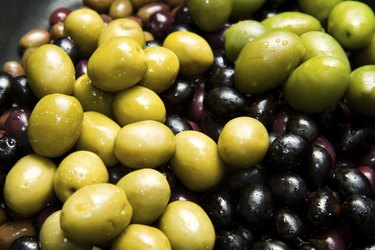
The nutritional make-up of black and green olives is nearly identical. The biggest nutritional difference is in the sodium content -- green olives contain about twice as much sodium as black olives. The difference in color is primarily due to the olive's ripeness when picked but is also affected by processing methods.
About Green Olives
Video of the Day

Green olives are harvested when they are unripe. They are soaked in a lye solution, then fermented in a brine solution for six to 12 months before packing. Green olives are usually pitted and are often stuffed with pimientos, almonds, garlic or onions. Pimiento-stuffed manzanilla olives from Spain are common in the U.S. The suggested serving size is 15 gram, or five medium olives.
Video of the Day
About Black Olives

Black olives are allowed to ripen on the tree. They are also soaked in a lye solution to leach out natural bitterness, then brine-cured. Black olives are graded based on size. A 15 grams serving contains six small, five medium, four large, three extra large or jumbo, two colossal, one super-colossal, 2 tablespoon sliced or 1-1/3 tablespoon chopped black olives.
Nutrition Facts

A 15 gram serving of green olives contains 20 calories, while black olives contain 25 calories. The calories come primarily from fat -- 2 grams total fat, less than 0.5 grams saturated or polyunsaturated fat and 1.5 grams heart-healthy monounsaturated fat. There is less than 0.5 grams of protein, 1 gram carbohydrate, 0.5 gram fiber and no cholesterol or trans fats in a serving. The suggested serving size contains only small amounts of vitamins and minerals -- 2 percent of the daily value for vitamin E and 1 percent of the DV for vitamin A.
Sodium

Because they are cured by pickling in a brine solution, both black and green olives contain a considerable amount of sodium. Sodium raises blood pressure levels, and high sodium intake is associated with increased rates of cardiovascular disease and stroke. The 2010 Dietary Guidelines Advisory Committee recommends that all Americans reduce their sodium intake to no more than 1,500 mg daily. Five medium black olives contain 115 to 125 milligrams of sodium, or 8 percent of this recommended amount. The same serving of green olives contains 218 to 360 milligrams of sodium, or 14 to 24 percent of the recommendation.